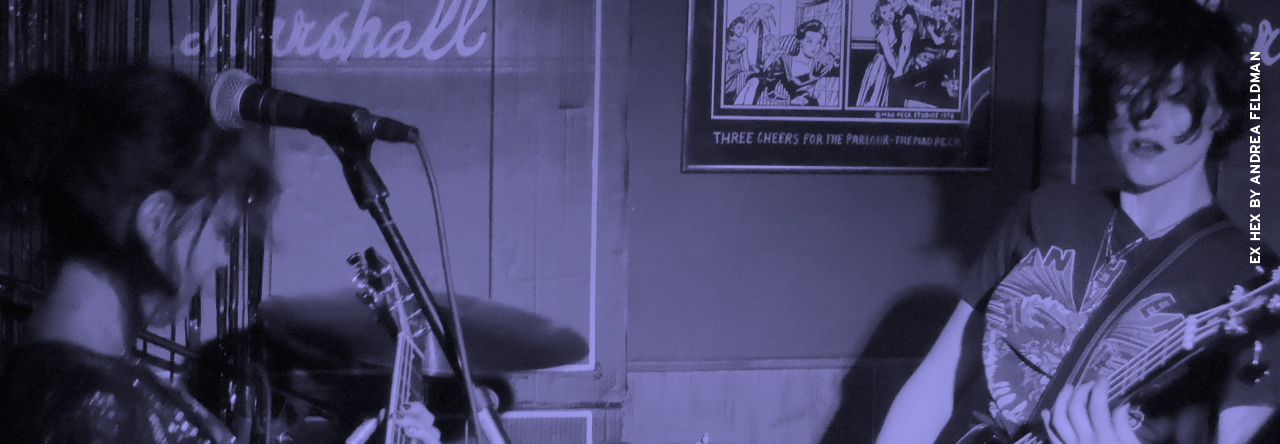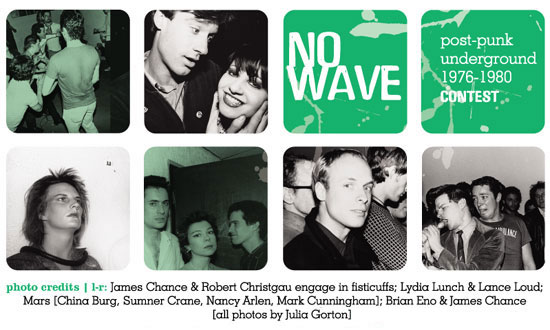From the beginning, No Wave was an anti-movement set up in stark opposition to punk’s tired reliance on conventional three-chord riffs. Stylistically exploiting the frisson between crudity and sophistication, groups like Suicide, DNA, and Ut reflected New York City’s moral chaos back on itself, turning art into shock therapy. (TV Party‘s Glenn O’Brien once quipped that No Wave was “a Gong Show for geniuses.”)
From such assaultive beginnings, No Wave proved to be a complicated, elastic, genre-hopping beast. Subsequently, its influence has proven more long-lasting than the movement itself: its blend of twitchy disco, corrosive noise, and lo-fi recording techniques shifted paradigms, throwing off the lumbering bombast of mid ‘70s MOR with short, sharp, shocking songs that drew blood, striking nerves as well as chords. A generation later, these sounds are still au courant.
Here, Robin Crutchfield (DNA, Dark Day) ; Sally Young, Nina Canal, and Jacqui Ham of Ut ; and Phil Kline (the Del-Byzanteens, Dark Day) offer up their recollections.
Robin Crutchfield: Lydia Lunch of Teenage Jesus & the Jerks coined the phrase in an interview inNew York Rocker with Roy Trakin, when he asked her if her music was “new wave.” She leered and jeered at him like he was an idiot, with the crack “’New Wave’? More like No Wave!!!” You’d have to talk to her, but her band and a few others really reacted against the whole 3-chord rock school of bands that were coming out of England like the Sex Pistols. It was a kind of disassembling of what passed for the time as rock and roll, taking apart the chords, the rhythms, the over-rehearsed quality of it. It needed to be screamingly raw and fresh like a newborn baby, screaming its lungs out, pulled into a polyester 70s world of American tedium.
Jacqui Ham, Ut: Originally there were two kinds of aesthetics going on: the sound of the so-called “No Wave” was more dirt, raw, dissonance —harder in every way; the Soho sound was arty, intellectual, detached. This division was present even in the Talking Heads vs. Television and the Ramones, which were the East Village thing. The line was blurred, but there was a kind of reverence in Soho, in part because they were interfacing with the idea of being serious composers or they were artists coming in from that perspective.
The “No Wave” thing was more irreverent, but it wasn’t a case of academic vs. not. Only a few people were coming in from a trained perspective, but everyone was influenced by avant-garde classical composers. You heard Einstein on the Beach blaring out of windows mixing with “Lady Marmalade.” This was the environment. People’s musical backgrounds varied, but it wasn’t necessarily influencing what they were doing —it depended on how much they were, or chose to be, indoctrinated by their past.
Robin: I recall that time as one where the scene burst wide open to experimentation, from art into music. It was the beginning of the do-it-yourself era with bands, labels, and venues breaking out of old molds and trying new things.
The most wonderful thing about it to me was to spread the word that, hey, you don’t need musical training, or even much talent: if you’ve the will, you’ll find the way… When it comes down to it, rock music isn’t about skill, it’s about the need for self-expression.…
Nina Canal, Ut: There were people from literally all musical corners and many other disciplines who quickly gravitated toward this scene —which was so wide open.
Phil Kline: The point is that everybody felt that all of it —rock, weird music, performance, film— was art and that, in a way, anyone who was serious was an equal, regardless of “credentials.” The way you lived was art. It sounds pretentious but it wasn’t really.
Robin: The scene started smaller, poor downtown artists and kids hanging out at art gallery openings for the free wine, and sharing ideas at cheap Tribeca Bars. A lot of the collaboration came through attending a variety of small events like performance art and private loft concerts and so on. Hanging out, meeting, talking into the night about ideas. Pooling money to timeshare rehearsal spaces.
When you didn’t have a job, or a TV, and only had a cheap crash pad on the lower east side with low rent, there wasn’t much to occupy your time but make art, talk about art, and experience other people’s art. As bands we even pooled our efforts to make our way into bookings at places like CBGB’s where the music was a little too different from The Ramones or Patti Smith to interest Hilly Krystal into booking us. We peppered the audience at early gigs with our own raucously cheering supporters leaving Hilly to think that this actually had appeal to more than a few.
The audiences started out being other bands and artists who were very supportive. You had a few old school rock fans cursing and throwing bottles, but mostly they were made to feel like they weren’t cool; like they were somehow out of the loop, their jeers being drowned out by supporters cheers and screams. The foundations of people who thought they were cool were pulled right out from under them.
Lydia [Lunch] could tell you a lot about that. She punished her audiences with brilliantly brutal music; no two hour sets with 20 minute guitar solos, Teenage Jesus & the Jerks delivered 8 minute sets of one minute songs, in a one-two punch onslaught that had them begging for more. She was an artistic underage genius! She minimalized the structure of her music, abbreviated it, and punctuated it. She took away her drummer’s drums and left him with only a snare and one cymbal to play. I think at one point she even made him use only one drumstick. The basslines were simple and insistent. Her guitar stopped and started in spasmodic jerks the way a sob grabs at you. I really think Teenage Jesus & the Jerks as a conception was the most amazing thing that came out of music in the entire decade of the ’70s.
Nina: NYC in late ‘77–‘80 was in a magical zone of sorts. I had come from London after the swinging ‘60s & 70s and NY actually blew my mind completely by being a place where anything was creatively possible! The scene that happened came about organically and spontaneously and burned out fast because it went against the “normal” grain of the way of things from the start. It was at once anarchic and inclusive: everyone was equal for the blink of an eye, so the field of possibilities just went wide open —BANG, just like that. And also just as suddenly there were other people of all disciplines starting up bands to play what I call “weird loud music” or spoken word stuff too, and yes, it was very village-like in many ways, with most living in the East Village or at least downtown.
Jacqui:There was a consciousness of making a new music, of progressing.
There was a natural progression from the Velvet Underground to Mars, as there was from 60’s rock to the Ramones. It was organic, but it was radical. It was stripping down to the essence, taking things further, taking things as far as they would go.
![]() Ut, “Fire In Philly” (from the Blast First comp Nothing Short of Total War, Vol. 1)
Ut, “Fire In Philly” (from the Blast First comp Nothing Short of Total War, Vol. 1)
![]() Dark Day, “No, Nothing Never” (from Exterminating Angel), 1981)
Dark Day, “No, Nothing Never” (from Exterminating Angel), 1981)
![]() The Del-Byzanteens, “Girl’s Imagination” (from The Del-Byzanteens), 1981)
The Del-Byzanteens, “Girl’s Imagination” (from The Del-Byzanteens), 1981)


